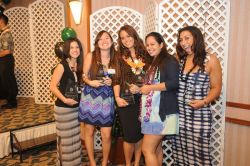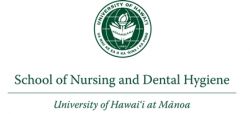A Culture of “Ohana”--Cultural Diversity and a Sense of Community Make the University of Hawaiʻi at Manoa a True Paradise
When NCIN Scholar Angela Cash moved from Los Angeles to Mānoa to pursue an accelerated MSN degree at the University of Hawaii at Mānoa (UH Mānoa) School of Nursing in Honolulu, she discovered living in Hawaii was like “living in another country.” The native culture is not only respected, it’s celebrated, as are the cultures of people
who live there and represent a variety of racial and ethnic backgrounds.
One of the first signs that her experience at UH Mānoa would be very different from her undergraduate years at Cal State Long Beach was the orientation ceremony at which everyone received a lei and there were performances of Native Hawaiian songs and dances. Another surprise was that on her very first day on campus, Allen Hanberg, PhD, RN, the program director for the master’s entry program in nursing, asked her to come talk to him in his office. “I thought that maybe I hadn’t done well on the application or something,” said Cash. “But he just wanted to check in with me and make sure that I was adjusting well because he knew how different Hawaii is from the mainland. I’d never had an advisor tell me to come to his office just to check in with me.”
That “check in,” and Hanberg’s recommendation that Cash come by his office and let him know if she ever had any issues or problems, are one sign of Hawaii’s culture of “Ohana.” As Hanberg explains it, this is “expanding your family to include those around you.”
“In Hawaii, and on campus, you hear the term ‘ohana’ a lot,” he said. “Hawaiians believe it’s important to develop close, almost familial relationships with people with different heritages and of different ethnicities. You grow Ohana outside your immediate family.”
Ohana is just one of many gifts the native culture of Hawaii has given to people who come to the state who are not Native Hawaiians. Another is not just respect for but a practice of embracing diversity. One reason for this may be the diverse people who have come to settle in the state over the years.
“Micronesians, Samoans, Filipinos, Japanese, Chinese, Vietnamese, and others have all come to these tiny islands in the middle of the Pacific,” said Hanberg. “Pacific Islander culture has been very welcoming of all these cultures. They show kindness and respect of cultures. And that’s something you also see here on campus.”
NCIN Deputy Program Director Vernell DeWitty, PhD, RN, experienced first-hand the remarkable cultural and ethnic diversity of this state of islands and the way that diversity is embraced and celebrated when she spoke at the summer celebration this year.
“When Allen invited me to come speak at their summer celebration, he talked about the diversity in Hawaii,” said DeWitty. “He said, ‘you would not believe the diversity here.’ And he was right. Accepting and celebrating diversity is just the ‘way it is.’ People’s cultures are recognized and respected and embraced.”
Elizabeth Stolzman is an NCIN scholar in her second year in the accelerated MSN program, and a native of Hawaii. She believes that the culture of embracing diversity at UH Mānoa in infused into the nursing program and that is preparing her well to provide care for a diverse patient population, and will make her a better nurse.
“The UH also really fosters your commitment to your community,” said Stoltzman. “I want to give back to my community after graduation. I’d like to focus on preventive care because that’s something that people in the community I come from don’t really understand. I want to be someone who looks like them and can speak to them, using their slang, and teach them how to live healthier lives.”
Mary Boland, DrPH, RN, FAAN, dean of the School of Nursing says that faculty and students at UH Mānoa says it’s important to have students like Cash – a California native who is half African American and half Filipino – and Stoltzman – who is Hawaiian and Portuguese – in order to “create a fabric that is reflective of all our ethnicities.”
“When we first thought about applying for an NCIN grant, we looked at our population and the Hawaii nursing workforce,” said Boland. “Less than five percent of Native Hawaiians are in the nursing workforce – they’re significantly underrepresented. We work hard to recruit them, as well as Latinos who are a growing population here, and men. But trying to recruit students from underrepresented communities is a challenge.”
To address that challenge, Nalani Minton developed a program with the School of Nursing and Dental Hygiene called Ike Ao Pono, which she now directs. Through Ike Ao Pono, UH Mānoa has recruited and graduated more than 200 Native Hawaiians and Pacific Islanders The program works with organizations that serve Native Hawaiians, holding open houses and outreach to high schools. Ike Ao Pono also focuses on cultural enrichment for student success.
“What makes Hawaii paradise isn’t the beaches, the sea, the whales, the sun or the scenery,” said Hanberg. “It’s the people and the culture. The diversity that exists and how accepting people are of that culture of diversity. That’s what makes our school and this state paradise.”

